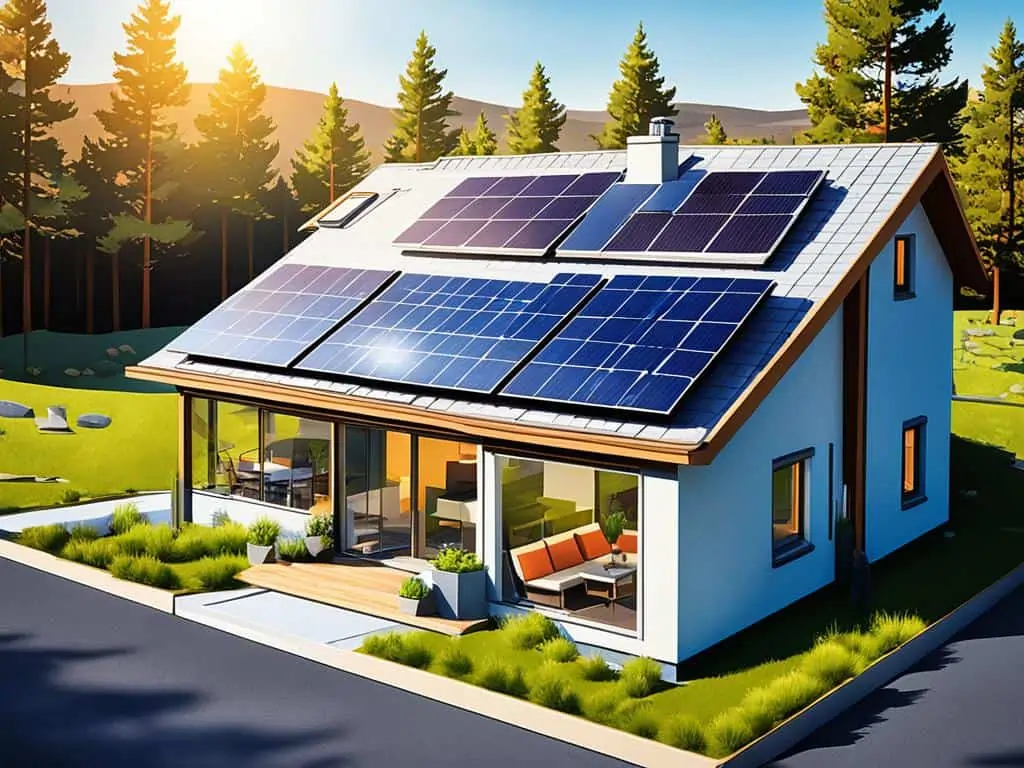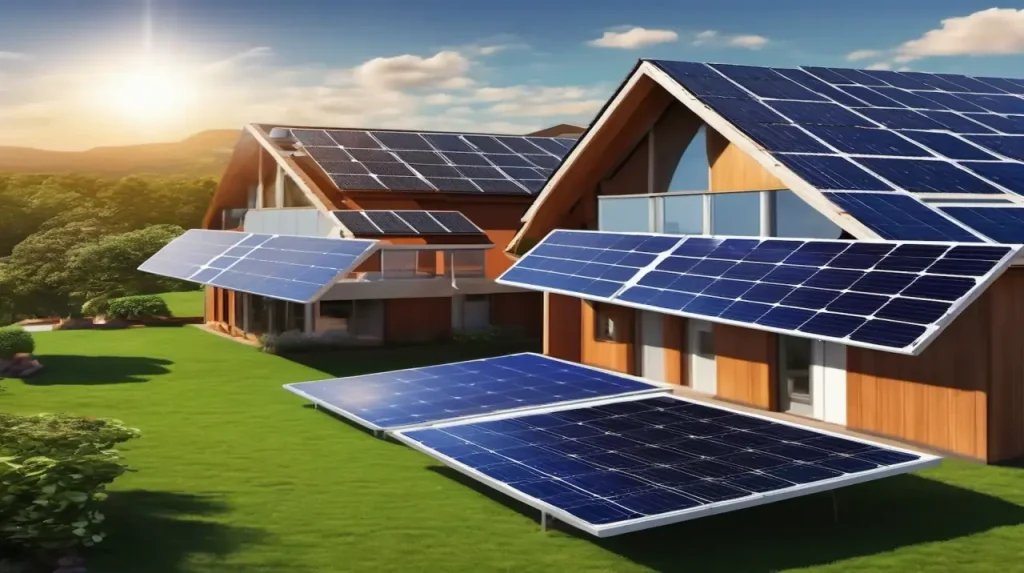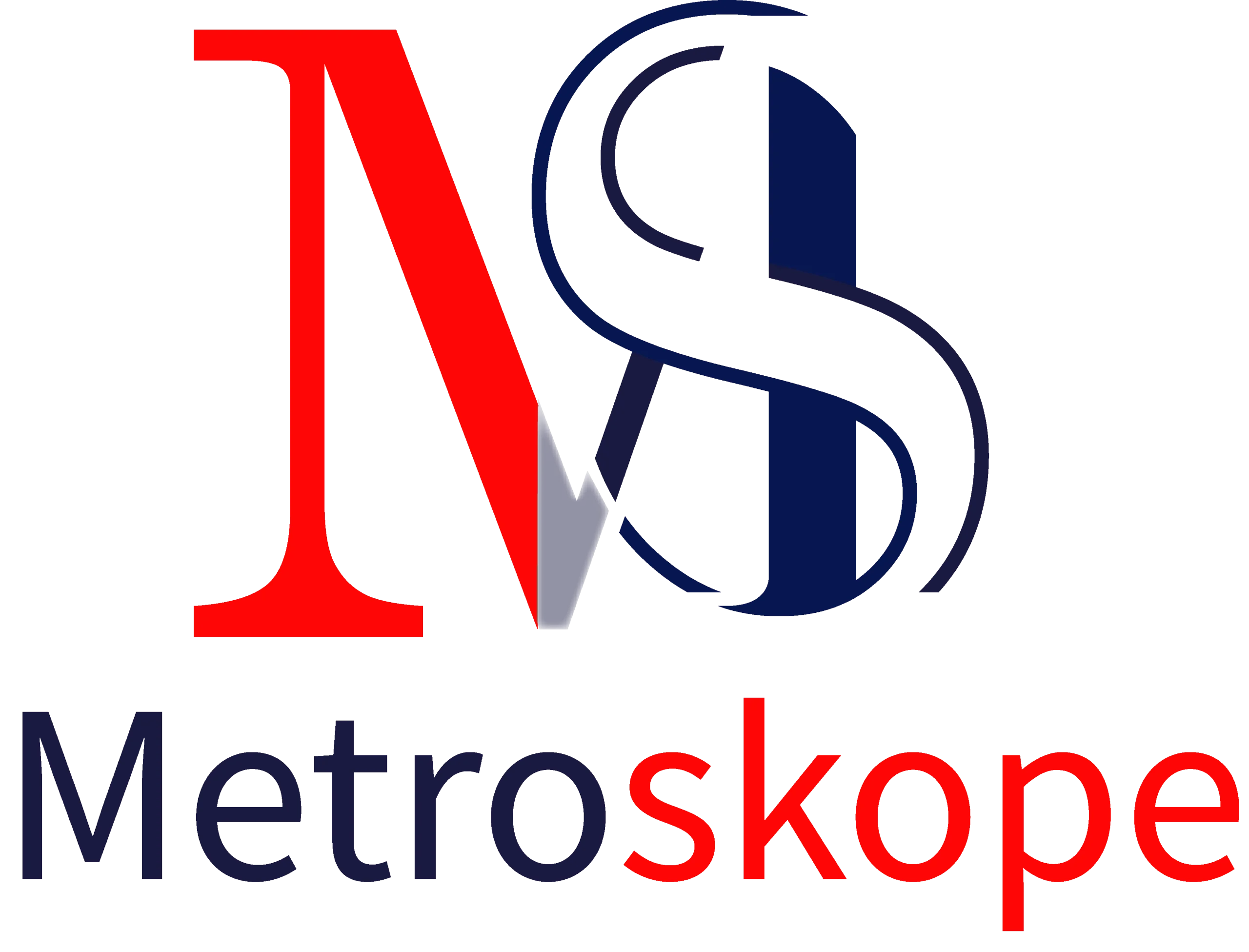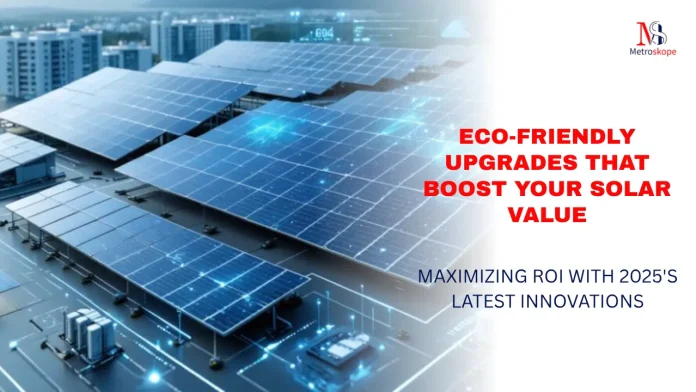The renewable energy revolution is reaching new heights in 2025, and savvy homeowners are discovering that strategic eco-friendly upgrades can significantly amplify their solar investment returns.
With solar panel efficiency now reaching unprecedented levels and property values increasing by up to 4.1% for homes with renewable energy systems, the time has never been better to maximize your solar value through complementary green upgrades.
The 2025 Solar Efficiency Breakthrough: What’s Changed
Revolutionary Technology Advances
The solar industry has experienced a technological renaissance in 2025, with breakthrough innovations pushing efficiency boundaries beyond previous limitations.
Commercial solar panel efficiency is now reaching 24-26% by 2025, with premium products potentially achieving 28-30% efficiency. This represents a substantial increase from today’s average commercial panel efficiency of 15-20%.
Key technological breakthroughs include:

- Perovskite-silicon tandem cells achieving record 33.9% efficiency, surpassing single-junction silicon cell theoretical limits
- Advanced photovoltaic technologies incorporating quantum dot technology and novel surface texturing methods
- Multi-junction cell architectures with enhanced light absorption techniques and reduced electron recombination losses
Next-Generation Panel Technologies
Standard solar efficiency in 2025 is ranging from 20-25%, with some advanced models exceeding this range.
Next-generation technologies such as perovskites, multi-junction cells, and tandem cells are pushing efficiency boundaries to 30-50%.
| Technology Type | Efficiency Range | Key Benefits |
|---|---|---|
| Monocrystalline PERC | 22-24% | Excellent low-light performance, space-efficient |
| Bifacial Panels | 20-22% (both sides) | Dual-sided energy capture, 30% more energy generation |
| Perovskite Tandem | 28-35% | Lightweight, flexible, broader spectrum absorption |
| TOPCon Technology | 24-26% | Reduced electron recombination, enhanced durability |
Strategic Eco-Friendly Upgrades That Amplify Solar Value
1. Smart Home Integration: The Ultimate Solar Multiplier
Combining solar panel installations with smart home technology offers enhanced energy efficiency and better management of solar energy.
This integration allows for optimized energy use and cost savings while promoting sustainability.
High-Impact Smart Upgrades:
- Smart thermostats like Nest or Ecobee that learn household patterns and adjust based on solar energy production levels
- Smart lighting systems with occupancy sensors and LED technology that maximize solar energy utilization during peak production
- Energy monitoring systems that track and optimize consumption in real-time
- Smart appliance scheduling to operate during peak solar production times
The ROI on smart thermostats is particularly impressive, offering excellent returns as a relatively low-cost upgrade that appeals to both tech-savvy and eco-conscious buyers.
2. Energy Storage Systems: Maximizing Solar Investment
The integration of energy storage systems with solar panels is witnessing significant advances in 2025.
Advanced battery technologies, such as lithium-ion and flow batteries, offer higher energy density, longer lifespan, and improved charging capabilities.
Storage Benefits:
- Store excess energy generated during peak solar production for use during non-production hours
- Increased energy independence and resilience during grid outages
- Optimized energy costs through time-of-use pricing strategies
- Enhanced property appeal to environmentally conscious buyers
3. Building-Integrated Photovoltaics (BIPV): The Future is Here
Building-integrated photovoltaics are solar cells that can harvest solar energy while preserving the functionality of conventional building materials. This revolutionary approach includes:
- Solar glass windows that generate electricity while maintaining transparency
- Solar roof tiles that replace traditional roofing materials
- Solar facades integrated into building walls
- Solar awnings and canopies for additional energy generation
4. Energy-Efficient Windows and Insulation: The Perfect Solar Complement
Energy loss through outdated windows and insufficient insulation accounts for up to 30% of heating and cooling waste in typical homes.
Upgrading to energy-efficient components maximizes solar energy benefits:
Window Upgrades:
- ENERGY STAR-certified double or triple-pane windows can lower household energy bills by an average of 12%
- Low-emissivity (Low-E) coatings for maximum energy savings and buyer appeal
- Smart glass technology that adjusts tint based on sunlight intensity
Insulation Improvements:
- Eco-friendly insulation materials such as recycled denim or sheep’s wool
- Proper attic, wall, and foundation insulation reducing energy costs by 15-30%
- Advanced air sealing techniques to eliminate energy leaks
High-ROI Water Management Systems

Heat Pump Hot Water Integration
Switching to a heat pump hot water system is a cost-effective way to increase energy efficiency while reducing carbon emissions.
These systems use renewable energy to heat water, significantly saving on energy bills when paired with solar panels.
Water-Efficiency Upgrades
Water-saving fixtures not only conserve water but also lower utility bills. These affordable upgrades demonstrate commitment to sustainability:
- Low-flow toilets, faucets, and showerheads with EPA WaterSense labels
- Rainwater harvesting systems to reduce pressure on water supply systems
- Greywater systems for garden irrigation during drought periods
- Smart irrigation systems that optimize water usage based on weather and soil conditions
The Financial Impact: Real Numbers, Real Returns
Property Value Increases
Research consistently shows impressive returns on eco-friendly solar upgrades:
- Homes with solar panels sell for 4.1% more than those without, according to Zillow studies
- Buyers are willing to pay up to $10,000 more for properties equipped with solar systems
- Properties can appreciate by about 3% to 4% more than comparable homes lacking solar energy
Long-Term Savings Calculations
| Upgrade Type | Initial Investment | Annual Savings | Payback Period | 25-Year ROI |
|---|---|---|---|---|
| Solar + Smart Home | $25,000-$35,000 | $2,500-$4,000 | 6-8 years | 300-400% |
| Solar + Battery Storage | $30,000-$45,000 | $3,000-$5,000 | 8-10 years | 250-350% |
| Energy Windows | $15,000-$25,000 | $1,200-$2,000 | 8-12 years | 200-300% |
| Heat Pump System | $8,000-$15,000 | $800-$1,500 | 6-10 years | 250-400% |
Federal and State Incentives
2025 offers unprecedented incentive opportunities:
- Federal tax credits of 30% of installation costs for solar systems
- Additional rebates for energy storage systems in many states
- Utility company incentives for smart home integration
- Local tax breaks for comprehensive eco-friendly upgrades
Advanced Technologies Reshaping Solar Value
Artificial Intelligence and IoT Integration
The integration of artificial intelligence and IoT in smart solar panels is revolutionizing energy management. AI-powered systems can:
- Predict energy production based on weather patterns and historical data
- Optimize energy distribution throughout the home automatically
- Identify maintenance needs before equipment failures occur
- Maximize energy trading opportunities with utility companies
Regional Considerations and Climate Optimization
Climate-Specific Upgrades
Different climates require tailored approaches to maximize solar value:
Hot Climate Zones:
- Reflective roofing materials to reduce cooling loads
- Advanced ventilation systems powered by solar energy
- Thermal mass improvements for natural temperature regulation
Cold Climate Zones:
- Ground-source heat pumps for efficient heating
- Triple-pane windows with superior insulation properties
- Solar heating systems for space and water heating
Mixed Climate Zones:
- Seasonal energy storage capabilities
- Adaptive HVAC systems that switch between heating and cooling efficiently
- Weather-responsive automation for optimal year-round performance
Implementation Strategy: Phased Approach to Maximum Value
Phase 1: Foundation (Months 1-3)
- Solar panel installation with latest 2025 technology
- Basic energy monitoring systems
- LED lighting conversion throughout the home
- Programmable thermostat installation
Phase 2: Integration (Months 4-6)
- Energy storage system addition
- Smart home device integration
- Window upgrade projects
- Insulation improvements
Phase 3: Optimization (Months 7-12)
- Advanced automation system deployment
- Water management system installation
- BIPV integration for additional generation
- Energy trading platform participation
Future-Proofing Your Investment

Emerging Technologies to Watch
2025 and beyond promise even more revolutionary developments:
- Transparent solar cells for vehicle and mobile applications
- Concentrated solar power integration for residential use
- Solar paint and flexible solar films
- Wireless energy transmission for remote system monitoring
Maintenance and Longevity Strategies
Protecting your eco-friendly investment:
- Preventive maintenance schedules for all systems
- Performance monitoring and optimization services
- Technology upgrade pathways for future enhancements
- Warranty management and system protection plans
Market Trends and Buyer Preferences
Growing Environmental Consciousness
Environmental awareness continues to drive market demand:
- 78% of homebuyers consider energy efficiency a priority factor
- Millennials and Gen Z buyers specifically seek sustainable features
- Corporate sustainability goals driving commercial demand
- Climate change concerns increasing urgency for renewable energy
Competitive Market Advantages
Properties with comprehensive eco-friendly upgrades gain significant market advantages:
- Faster sale times in competitive markets
- Higher buyer interest and showing attendance
- Premium pricing justification through documented savings
- Reduced time on market due to unique value propositions
The Time is Now
2025 represents a pivotal moment for homeowners seeking to maximize their solar investment through strategic eco-friendly upgrades.
With solar panel efficiency reaching new heights, innovative storage solutions becoming affordable, and smart home integration offering unprecedented optimization, the opportunity to create a truly valuable and sustainable property has never been greater.
The combination of technological breakthroughs, favorable policies, and growing market demand creates ideal conditions for homeowners to significantly boost their property value while reducing their environmental footprint.
Those who act now will benefit from current incentives while positioning themselves advantageously in an increasingly competitive real estate market that values sustainability.
The future of energy is renewable, intelligent, and integrated. By implementing these eco-friendly upgrades alongside your solar installation, you’re not just reducing energy costs—you’re creating a valuable asset that will appreciate for decades to come.

